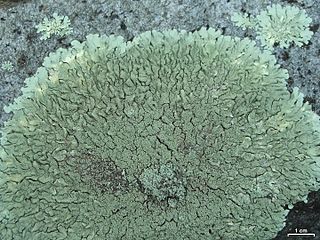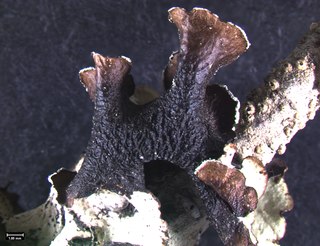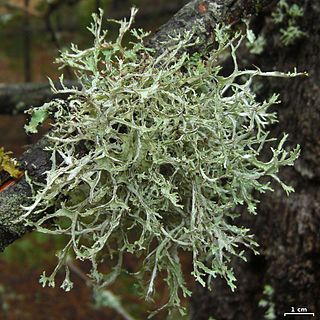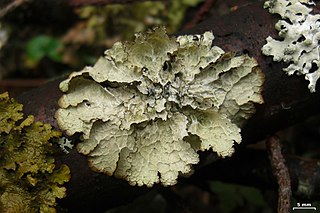
Hypogymnia is a genus of foliose lichens in the family Parmeliaceae. They are commonly known as tube lichens, bone lichens, or pillow lichens. Most species lack rhizines that are otherwise common in members of the Parmeliaceae, and have swollen lobes that are usually hollow. Other common characteristics are relatively small spores and the presence of physodic acid and related lichen products. The lichens usually grow on the bark and wood of coniferous trees.

Melanohalea is a genus of foliose lichens in the family Parmeliaceae. It contains 30 mostly Northern Hemisphere species that grow on bark or on wood. The genus is characterised by the presence of pseudocyphellae, usually on warts or on the tips of isidia, a non-pored epicortex and a medulla containing depsidones or lacking secondary metabolites. Melanohalea was circumscribed in 2004 as a segregate of the morphologically similar genus Melanelia, which was created in 1978 for certain brown Parmelia species. The methods used to estimate the evolutionary history of Melanohalea suggest that its diversification primarily occurred during the Miocene and Pliocene epochs.

Cetrelia is a genus of leafy lichens in the large family Parmeliaceae. They are commonly known as sea-storm lichens, alluding to the wavy appearance of their lobes. The name of the genus, circumscribed in 1968 by the husband and wife lichenologists William and Chicita Culberson, alludes to the former placement of these species in the genera Cetraria and Parmelia.

Xanthoparmelia is a genus of foliose lichens in the family Parmeliaceae. This genus of lichen is commonly found in the United States, as well as Australia, New Zealand and Ecuador.
Chicita Frances Culberson was an American lichenologist.

Menegazzia terebrata is a species of foliose lichen found scattered across many continents, including North America, South America, Europe, Africa, and Asia.

Platismatia wheeleri is a species of foliose lichen in the family Parmeliaceae. Found in western North America, it is characterized by its whitish, smooth thallus and asexual reproduction through soredia. This lichen species is primarily found in western intermontane North America, from southern British Columbia to Washington, Idaho, and Oregon. It has also been discovered in southern California and the Tatra Mountains of Slovakia.
Hypogymnia congesta is a rare species of foliose lichen in the family Parmeliaceae. Found in China, it was formally described as a new species in 2003. The lichen grows on the bark and wood of conifers and bamboo. Hypogymnia congesta has a brown to brownish-grey foliose thallus measuring up to 8 cm (3.1 in) long or broad, with a cartilage-like texture. The lichen is chemically distinct, containing physodic acid and virensic acid; the latter substance is otherwise unknown from genus Hypogymnia.

Punctelia hypoleucites, commonly known as the southwestern speckled shield lichen, is a species of foliose (leafy) lichen in the family Parmeliaceae. First formally described by Finnish botanist William Nylander as a species of Parmelia, it was transferred to the genus Punctelia in 1982. The lichen is found in Africa, North America, and South America, where it grows on the bark of both hardwood and coniferous trees. Its greenish-grey thallus is covered with tiny white pseudocyphellae – minute holes in the thallus surface that facilitate gas exchange. Some macroscopic features that help distinguish this species from other related members of the genus include the presence and the structure of the apothecia, the absence of asexual surface propagules, and the light brown color of the thallus undersurface. Chemically, the presence of lecanoric acid in the medulla and atranorin in the cortex help distinguish it from lookalikes.

Punctelia graminicola is a species of foliose (leafy) lichen in the family Parmeliaceae. It grows on rocks, and, less frequently, on bark in North America, South America, and East Africa. It has a blue-grey thallus measuring up to about 15 cm (6 in), covered with tiny pores called pseudocyphellae. Sometimes the lichen forms small lobes that project out from the surface. Fruiting bodies are uncommon in this species; if present, they resemble small cups with a brown internal disc measuring 3–10 mm (0.1–0.4 in) in diameter. A lookalike species, Punctelia hypoleucites, is not readily distinguishable from Punctelia graminicola by appearance or habitat alone; these species can only be reliably differentiated by examining the length of their conidia.

Cetrelia chicitae is a species of foliose lichen in the family Parmeliaceae. It is found in eastern Asia, North America, and Europe, where it grows on mossy rocks and tree trunks.

Ramalina americana, commonly known as the sinewed ramalina, is a pale green fruticose lichen that is found across the Northern US Midwest, extending into Southern Canada and the Eastern Seaboard. It is characterized morphologically by the presence of pseudocyphellae, straight spores, and its unique chemical diversity.
Platismatia lacunosa is a species of corticolous (bark-dwelling), foliose lichen in the family Parmeliaceae. Known predominantly from western North America, it reproduces primarily through sexual means, which is uncommon in the genus. The species is distinguished by its ridged surface and large, folded apothecia.
Platismatia interrupta is a species of foliose lichen in the family Parmeliaceae. Found in southern Russian Far East, and Japan, it was formally described as a new species in 1968 by William and Chicita Culberson. The species epithet interrupta refers to the indistinct and discontinuous reticulation of the upper thallus surface. The lichen of one of the most common foliose macrolichens in Japan, particularly at high elevations, where it grows on tree trunks and on boulders. The authors called it the "Far Eastern equivalent" of the common and widespread Platismatia glauca, which is absent in Asia.

Platismatia stenophylla is a species of corticolous (bark-dwelling), foliose lichen in the family Parmeliaceae. It is found in western North America, from Vancouver Island south to central California, usually close to a shore. The lichen is distinguished from others in its genus by its narrow, linear lobes and primarily sexual reproduction.

Platismatia tuckermanii is a species of corticolous (bark-dwelling), foliose lichen in the family Parmeliaceae. It is endemic to Eastern North America and is distinguished by its broad, loosely attached lobes and primarily sexual reproduction.

Platismatia herrei is a species of corticolous (bark-dwelling), foliose lichen in the family Parmeliaceae. It was first formally described as a species of Cetraria in 1968 by lichenologist Henry Imshaug. William and Chicita Culberson transferred it to the genus Platismatia in 1968. The lichen is found in western North America, ranging from southern Alaska to central California. It is distinguished from other members of its genus by the isidia that fringe the edges of its linear lobes; the Culbersons described it as "one of the most beautiful and intricately formed species in the genus".

Pseudevernia consocians is a species of lichen in the family Parmeliaceae. It is found in both North America and Central America. Some characteristic features of Pseudevernia consocians are its well-developed, numerous isidia, relatively narrow lobes, and the presence of the lichen product lecanoric acid.
Lethariella cashmeriana is a species of fruticose lichen in the family Parmeliaceae. It was formally described as a new species in 1976 by Hildur Krog. The species epithet cashmeriana refers to Jammu-Kashmir, where the type specimen was collected. The lichen is one of three species of Lethariella that is used as a purported health-promoting tea in Yunnan, China. It contains atranorin, canarione, gyrophoric acid, and norstictic acid (minor) as lichen products.
Lethariella sinensis is a species of fruticose lichen in the family Parmeliaceae. It was formally described as a new species in 1982 by Chinese lichenologists Jiang-Chun Wei and Yu-Mei Jiang. The type specimen was collected from Qamdo at an altitude of 4,300 m (14,100 ft); there, it was found growing on the branch of Thuja. It is an orange, long pendant lichen with a reticulate surface. In 2001, Walter Obermayer showed that the holotype specimen of Lethariella sinensis comprised two chemically unique taxa: one with psoromic acid and the other with norstictic acid. The former was chosen as the lectotype, and as a consequence, Lethariella mieheana became synonymous with L. sinensis.













